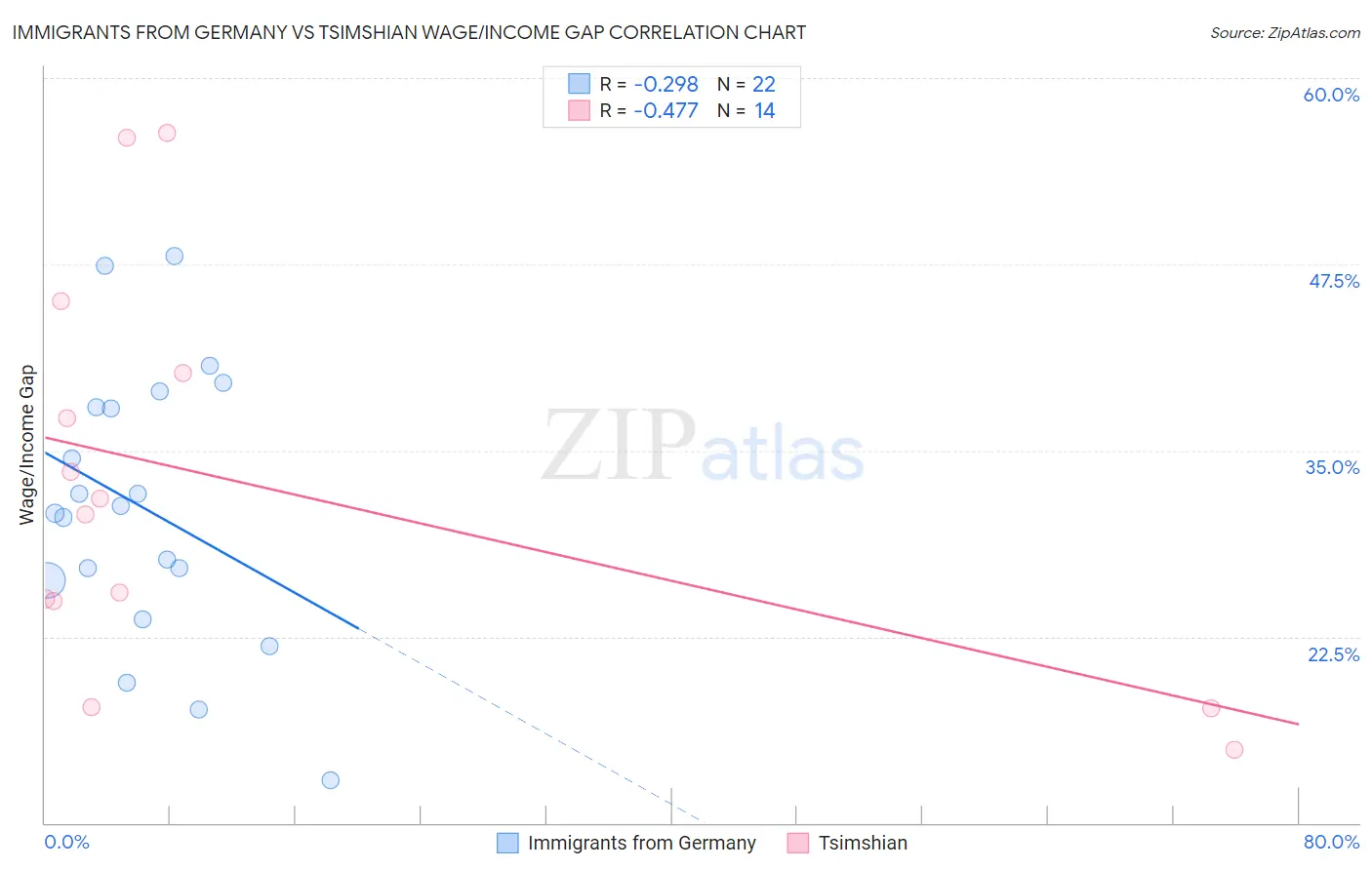Immigrants from Germany vs Tsimshian Wage/Income Gap
COMPARE
Immigrants from Germany
Tsimshian
Wage/Income Gap
Wage/Income Gap Comparison
Immigrants from Germany
Tsimshian
27.5%
WAGE/INCOME GAP
1.5/ 100
METRIC RATING
261st/ 347
METRIC RANK
23.9%
WAGE/INCOME GAP
98.9/ 100
METRIC RATING
103rd/ 347
METRIC RANK
Immigrants from Germany vs Tsimshian Wage/Income Gap Correlation Chart
The statistical analysis conducted on geographies consisting of 463,246,314 people shows a weak negative correlation between the proportion of Immigrants from Germany and wage/income gap percentage in the United States with a correlation coefficient (R) of -0.298 and weighted average of 27.5%. Similarly, the statistical analysis conducted on geographies consisting of 15,623,634 people shows a moderate negative correlation between the proportion of Tsimshian and wage/income gap percentage in the United States with a correlation coefficient (R) of -0.477 and weighted average of 23.9%, a difference of 15.3%.

Wage/Income Gap Correlation Summary
| Measurement | Immigrants from Germany | Tsimshian |
| Minimum | 12.9% | 14.9% |
| Maximum | 48.0% | 56.3% |
| Range | 35.1% | 41.4% |
| Mean | 31.1% | 32.6% |
| Median | 31.0% | 31.2% |
| Interquartile 25% (IQ1) | 26.3% | 24.9% |
| Interquartile 75% (IQ3) | 37.9% | 40.2% |
| Interquartile Range (IQR) | 11.6% | 15.3% |
| Standard Deviation (Sample) | 9.1% | 13.2% |
| Standard Deviation (Population) | 8.9% | 12.7% |
Similar Demographics by Wage/Income Gap
Demographics Similar to Immigrants from Germany by Wage/Income Gap
In terms of wage/income gap, the demographic groups most similar to Immigrants from Germany are Immigrants from Lebanon (27.5%, a difference of 0.010%), Syrian (27.6%, a difference of 0.10%), Tongan (27.5%, a difference of 0.26%), Icelander (27.5%, a difference of 0.28%), and Slavic (27.4%, a difference of 0.36%).
| Demographics | Rating | Rank | Wage/Income Gap |
| Israelis | 2.1 /100 | #254 | Tragic 27.4% |
| Immigrants | France | 2.1 /100 | #255 | Tragic 27.4% |
| Cherokee | 1.9 /100 | #256 | Tragic 27.4% |
| Luxembourgers | 1.9 /100 | #257 | Tragic 27.4% |
| Slavs | 1.8 /100 | #258 | Tragic 27.4% |
| Icelanders | 1.8 /100 | #259 | Tragic 27.5% |
| Tongans | 1.7 /100 | #260 | Tragic 27.5% |
| Immigrants | Germany | 1.5 /100 | #261 | Tragic 27.5% |
| Immigrants | Lebanon | 1.5 /100 | #262 | Tragic 27.5% |
| Syrians | 1.4 /100 | #263 | Tragic 27.6% |
| Immigrants | Switzerland | 1.0 /100 | #264 | Tragic 27.7% |
| Serbians | 1.0 /100 | #265 | Tragic 27.7% |
| Hmong | 1.0 /100 | #266 | Tragic 27.7% |
| Turks | 1.0 /100 | #267 | Tragic 27.7% |
| New Zealanders | 1.0 /100 | #268 | Tragic 27.7% |
Demographics Similar to Tsimshian by Wage/Income Gap
In terms of wage/income gap, the demographic groups most similar to Tsimshian are Immigrants from Laos (23.8%, a difference of 0.23%), Tlingit-Haida (24.0%, a difference of 0.33%), Japanese (23.8%, a difference of 0.37%), Moroccan (24.0%, a difference of 0.39%), and Sudanese (24.0%, a difference of 0.39%).
| Demographics | Rating | Rank | Wage/Income Gap |
| Kiowa | 99.4 /100 | #96 | Exceptional 23.6% |
| Immigrants | Sudan | 99.4 /100 | #97 | Exceptional 23.6% |
| Immigrants | Latin America | 99.2 /100 | #98 | Exceptional 23.7% |
| Aleuts | 99.2 /100 | #99 | Exceptional 23.7% |
| Yakama | 99.2 /100 | #100 | Exceptional 23.7% |
| Japanese | 99.1 /100 | #101 | Exceptional 23.8% |
| Immigrants | Laos | 99.0 /100 | #102 | Exceptional 23.8% |
| Tsimshian | 98.9 /100 | #103 | Exceptional 23.9% |
| Tlingit-Haida | 98.7 /100 | #104 | Exceptional 24.0% |
| Moroccans | 98.6 /100 | #105 | Exceptional 24.0% |
| Sudanese | 98.6 /100 | #106 | Exceptional 24.0% |
| Yaqui | 98.4 /100 | #107 | Exceptional 24.0% |
| Immigrants | Albania | 98.4 /100 | #108 | Exceptional 24.0% |
| Ugandans | 98.3 /100 | #109 | Exceptional 24.1% |
| Immigrants | Morocco | 98.1 /100 | #110 | Exceptional 24.1% |